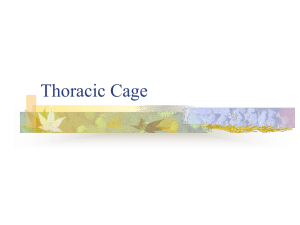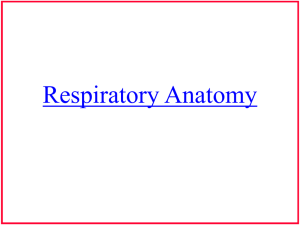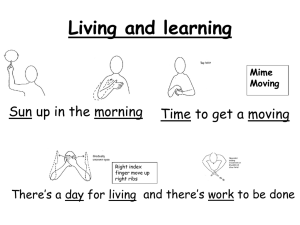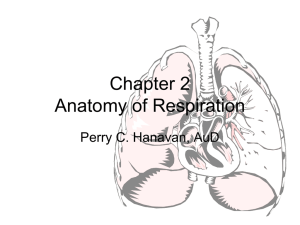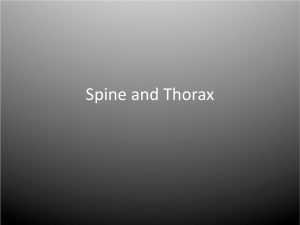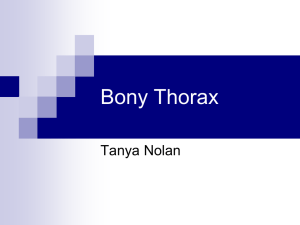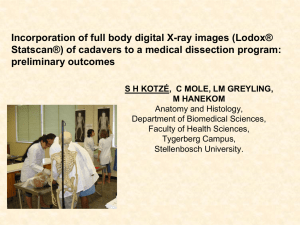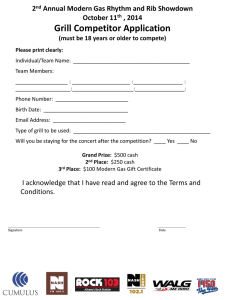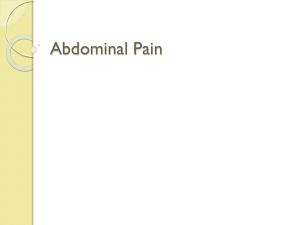08 – Bony Anatomy of the Thorax
advertisement
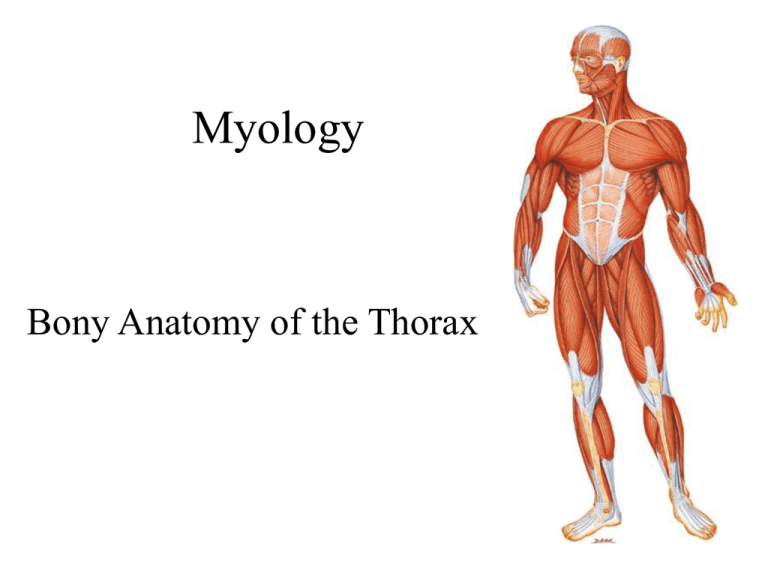
Myology Bony Anatomy of the Thorax 1 Gross Anatomy Osteology of the Thorax 2 Thorax • Thorax refers to the entire chest • Functions: – Protect organs in chest and upper abdomen – Provides support for bones of upper limbs • Bony cage flattened from front to back • Formed by: – Sternum – Ribs – Costal cartilages – Bodies of thoracic vertebrae. 3 • Sternum (breastbone) – Manubrium: upper portion • Suprasternal (Jugular) notch: depression in the upper part of the manubrium • Clavicular notches: lateral sides of manubrium, for articulation with the clavicle. • Body: middle and largest portion – Xiphoid: inferior and smallest portion – Sternal angle: formed by the junction of the manubrium and body • Ribs – Ribs 1-7 are true ribs: direct anterior attachment to sternum – Ribs 8-12 are false ribs: attaches indirectly to sternum or doesn’t attach to sternum at all – Ribs 11-12 are floating ribs: ends of ribs do not attach to sternum 4 5 Palpation of the Thorax Sternum: Supine; place your fingers on the center of the chest. Then slide superiorly toward the jugular notch at the top. Then move your fingers slightly lateral and palpate the sternoclavicular joints (confirm by having your partner move their upper extremity). Return to the sternum and palpate inferiorly onto the manubrium and body. Finally, slide your fingers down onto the xiphoid process feeling the tip between the costal cartilages. Ribs: Supine; slide laterally from the sternum onto the costal cartilages. Roll off the cartilage into the spaces between. Follow the costal cartilages laterally on to the ribs. 6 Pectoralis Major • Pec major along with the lats are important when performing a pullup. • Both pec major and lats are powerful muscles which attach from the trunk to the arm. – Synergistic to each other with respect to their arm action in that they both adduct and medially rotate the arm – However they are antagonistic with respect to their sagittal plan arm actions; pec major (being anterior) flexes the arm and the lats (being posterior) extends the arm. • Pectoralis major has layers: clavicular fibers are most superficial (anterior); the sternal fibers are deep to the clavicular fibers; and the costal and abdominal fibers attach more proximally on the humerus. • Makes up the vast majority of the “anterior axillary fold” of tissue, which borders the armpit anteriorly. • Can only create flexion of the arm at the shoulder joint up to 60°. • Powerful horizontal flexor of the arm at the shoulder joint. 7 Pectoralis Major O: Clavicular Head: Medial clavicle Sternal Head: Sternum and the upper costal cartilages I: Lateral lip of the bicipital groove A: Adduction, medial rotation, and horizontal adduction of the arm. The clavicular head also causes flexion of the arm. Secondarily depresses and protracts the scapula. **Reversed muscle action causes elevation of the trunk, lateral deviation, and ipsilateral rotation. N: Medial and Lateral Pectoral nerves Palpation: page 260 8 Pectoralis Minor • When contracting it pulls on the coracoid process and pulls scapula in such a manner that the lateral border is pulled in toward the lateral body wall and the medial border moves away from posterior body wall. – This movement is called lateral tilt. • Rounded shoulders is a common postural condition in which the scapulae are protracted and depressed and the humeri are medially rotated. – Given the pec minor’s action of both protraction and depression, when pec minor muscles are tight, they can contribute to this condition. • By elevating ribs 3-5, this muscle can expand the ribcage during inspiration (accessory muscle of inspiration) 9 Pectoralis Minor O: Anterior borders of ribs # 3 through 5 I: Coracoid process of the scapula A: Protracts, Depresses, and downwardly rotates the scapula **Reversed muscle action includes elevation of the 3rd through 5th ribs N: Medial pectoral nerve Palpation: page 264 10 Subclavius • If clavicle is fixed to the scapula, then subclavius can also depress the scapula at the scapulocostal joint • Many believe main function is to act as a fixator of the clavicle during arm/shoulder movements. • Common entrapment site for nerves of brachial plexus and subclavian artery called costoclavicular syndrome 11 Subclavius muscle is “under” the clavicle O: 1st rib I: Inferior surface of the clavicle A: Depression of the clavicle and Elevation of the 1st rib N: Nerve to the subclavius from the brachial plexus Palpation: page 267 12 External Intercostals • Oriented in the same direction as the external oblique abdominal muscles. – Appear to be extensions of external obliques • Involved in respiration • These muscles should be addressed in any client who has a respiratory condition. • This is the meat which is eaten when one eats spare ribs. 13 External Intercostals O: Inferior borders of ribs 1-12 I: Superior border of the rib below A: Elevation of ribs 2-12 N: Intercostal nerves Palpation: page 270 14 Internal Intercostals • Oriented in the same direction as fibers of the internal abdominal obliques. • Generally thinner then external intercostals. • Involved in respiration • There is another layer of muscles called the innermost intercostals which are located deep to the internal intercostals. 15 Internal Intercostals located between the ribs and internal to external intercostals O: Superior border of the rib below I: Inferior border of the rib above A: Depresses ribs 1-11 N: Intercostal nerves Not palpable 16 Transversus Thoracis • Superior fibers run primarily vertically but inferior fibers run horizontally • Located internally i.e. located within thoracic cavity • Primary role is as a respiratory muscle. 17 Transversus Thoracis Runs transversely across the thoracic region O: Internal surfaces of the sternum, xiphoid and adjacent costal cartilages I: Internal surfaces of costal cartilages 2-6 A: Depression of ribs 2-6 N: Intercostal nerves Not palpable 18 Diaphragm • Separates the thoracic and abdominal cavities. • Number of openings to allow passage of structures between thoracic and abdominal cavities. – Largest openings for esophagus, aorta and inferior vena cava • Only muscle that must contract for quiet, relaxed inspiration. • Usually under both conscious and unconscious control. • Innervation is phrenic nerve composed of spinal nerves C3, 4, 5. – “C3, 4, 5 keeps the diaphragm alive!” • Clinically a Hiatal hernia is when part of the stomach herniates through the diaphragm into the thoracic cavity. 19 Diaphragm O: Internal surfaces of ribcage, sternum and spine I: Central tendon of diaphragm A: Increases volume of thoracic cavity during inspiration N: Phrenic nerve Palpation: page 293 20 Muscles of the Anterior Abdominal Wall • Rectus abdominis located anteromedially • External/internal oblique and transversus abdominis located anterolaterally • All four muscles compress the abdominal contents. • All except transversus abdominis can flex the trunk. • External oblique of one side is synergistic with internal oblique of opposite side with trunk rotation. 21 Rectus Abdominis • Three fibrous bands known as tendinous inscriptions transect the rectus abdominis muscles and divide each into four sections or boxes. – For this reason, this muscle in a well developed person is often known as the eight-pack muscle (it is more often incorrectly labeled as the six-pack since six of eight compartments are more visible. • The two rectus sheaths which encase the rectus abdominis meet in the midline and form the linea alba. • When old-fashioned straight legged sit-ups are done, the movement occurs at the hip joint and not a the spinal joints. 22 Rectus Abdominis muscle runs straight up the abdomen O: Pubis I: Xiphoid and cartilages of ribs 5-7 A: Bilateral contraction: Flexion of trunk, Posterior tilt of pelvis, and compresses the abdominal contents Unilateral contraction: lateral flexion of the trunk N: Intercostal nerves, iliohypogastric, and ilioinguinal nerves Palpation: page 281 23 External Obliques • Located lateral to rectus abdominis • Most powerful of the 3 layers of the anterolateral abdominal wall – Directly deep to external oblique is internal oblique and deep to that is the transversus abdominis • If you put your hands in your coat pocket, your fingers would be pointing along the direction of this muscle. 24 External Abdominal Oblique located externally and fibers oriented obliquely O: Anterior iliac crest; pubic bone and abdominal aponeurosis I: Lower 8 ribs A: Bilateral contraction: Trunk flexion, Posterior tilt of pelvis, and compression of the abdominal contents. Unilateral contraction: Lateral trunk flexion, Contralateral trunk rotation, and elevation of the pelvis. N: Intercostal nerves, iliohypogastric, and ilioinguinal nerves 25 Palpation: page 284 Internal Obliques • If you were to put your hands in your back pockets, your fingers would be pointing along the direction of this muscle. • It is an ipsilateral trunk rotator and antagonistic to its external oblique partner on the same side. 26 Internal Abdominal Oblique located internally and fibers oriented obliquely O: Inguinal ligament, iliac crest and thoracolumbar fascia I: Lower 3 ribs and the abdominal aponeurosis A: Bilateral contraction: Trunk flexion, Posterior tilt of pelvis, and compresses the abdominal contents. Unilateral contraction: Lateral trunk flexion, Ipsilateral trunk rotation, and elevation of the pelvis N: Intercostal nerves, iliohypogastric, and ilioinguinal nerves Palpation: page 287 27 Transversus Abdominis • Is the only abdominal muscle that cannot act as a mover of a skeletal action. – Primary purpose is to compress the abdominal contents. • Upper fibers are contiguous with the diaphragm and the transversus thoracis. • Sometimes called the corset muscle because it wraps around the abdomen. 28 Transversus Abdominis O: Inguinal ligament, iliac crest, thoracolumbar fascia and lower costal cartilages I: Abdominal aponeurosis A: Compression of abdominal contents N: Intercostal nerves, iliohypogastric, and ilioinguinal nerves Palpation: page 287 29
